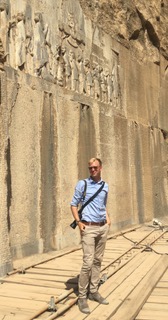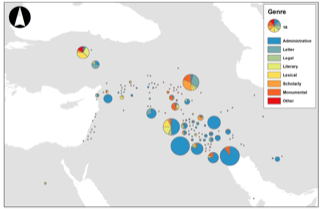
I started out as an Assyriologist*, specializing in the world of cuneiform, a script in broad use across much of the Middle East from c. 3,300 BC until c. 100 AD. Not too many are studying it, and relatively few of that exclusive lot were doing much with a computer. Later, for my doctorate, I ventured into landscape archaeology, a field which had next to nothing to do with cuneiform, something my doctoral supervisor gently pointed out to me when he said that I had committed quite a career suicide by coming over. At least in the short term. For the first year, I locked myself into a basement trying to learn the basics of GIS and remote sensing, with a whole bunch of nerds who knew nothing whatsoever about cuneiform, but very much about exotic abbreviations such as GPS, GCPs, CRS, LIDAR, UAV, and DEMs, and compound curiosities like georectification, least-cost-pathways, viewscapes, panchromatic, and shapefile. I found myself constantly returning to my supervisor’s office half a day after each meeting we had, to say that we fundamentally misunderstood each other concerning whatever interface between philology and landscape archaeology we had last discussed.
Gradually, however, I also realized that each of those meetings produced something genuinely new because, being so wildly unfamiliar with common knowledge in each other’s fields, we constantly found ourselves asking new questions, addressing new issues, seeing new perspectives in matter otherwise all told and accounted for. A lot of this came straight out of the elementary yet stimulating challenge of how to integrate data and knowledge from very different fields of research within a common frame. And that’s what I found so immensely fascinating about digital fora in an academic setting, then and now. That subtle ability of a shared methodological or technical forum to bring different perspectives, different minds, different disciplines together, oftentimes for purposes that were rarely immediately clear to anyone involved. Thus, my doctoral dissertation came to deal with a very novel combination of quantitative approaches to data contained in a couple of thousand administrative texts – and settlement patterns as derived from spatial data sets that the nerds in the basement had been playing around with for years. The core argument was that, when properly scaled within a formal and coherent analytical frame, ancient texts could indeed be brought to bear on conclusions derived from satellite imagery and site mapping at a regional level. In my case casting some decent, and empirically solid, light on the material size of early state economies.

My current work at Uppsala University, and my engagement with Digital Humanities Uppsala, is very much a result of those early exposures to very different ways of studying and approaching the past. Our brand-new research project at Assyriology, funded by Riksbankens Jubileumsfond and called Geomapping Landscapes of Writing, or GLoW for short, aims to trace the distributional and compositional outlines of a discrete historical record, namely the cuneiform corpus, in its entirety. Counting perhaps half a million known texts, spanning a temporal transect of some 3,000 years, and traversing a geographical area reaching from the central Mediterranean to the eastern deserts of Iran, this corpus offers an opportunity to study the role of writing in early human history, its material distribution and composition, from a birds-eye perspective. Such an undertaking would have been unthinkable a decade ago, and its methodology owes as much to landscape archaeology as it does to cuneiform studies. Related ideas underpin the research network TextWorlds: Global Mapping of Texts from the Pre-Modern World, another new initiative that I am involved in, funded by CIRCUS, which will bring together philologists, archaeologists, and historians from across the university to discuss and explore shared traits between written corpora from around the world. A crucial basis for such initiatives is the ability to work from a shared, read digital, methodological platform able to capture vast amounts of data from seemingly disparate disciplines, each with their own way of approaching and studying the past, and oversee it within a shared frame of scholarly inquiry. So, over the next three years, I am looking forward to spending even more time lingering over applications, programs, and code with researchers from across the humanities and social sciences, debating, experimenting, and discovering new ways of fusing together our various specialties. From past experience, I would say that fora like Digital Humanities Uppsala are perfect for that sort of activity.
* Don’t worry if you don’t know what that is. Back in the pre-digital age, one of my teachers had been enrolled at Psychology for most of his undergraduate years because the university administration didn’t know either.
